
| 1 1 Dahlman Rose Global Metals, Mining & Materials Conference November 17, 2010 Christina Morrow Vice President Investor Relations Exhibit 99.1 |

| 2 Statement on Forward-Looking Information Some of the following information contains forward-looking statements within the meaning of Section 27A of the Securities Act of 1933 and Section 21E of the Securities Exchange Act of 1934, as amended, and is intended to come within the safe-harbor protection provided by those sections. Our forward-looking statements are based on numerous assumptions that the company believes are reasonable, but they are open to a wide range of uncertainties and business risks that may cause actual results to differ materially from expectations as of Oct. 19, 2010. These factors are difficult to accurately predict and may be beyond the company's control. The company does not undertake to update its forward-looking statements. Factors that could affect the company's results include, but are not limited to: demand for coal in United States and international power generation and steel production markets; price volatility and demand, particularly in higher-margin products and in our trading and brokerage businesses; reductions and/or deferrals of purchases by major customers and ability to renew sales contracts; credit and performance risks associated with customers, suppliers, trading, banks and other financial counterparties; geologic, equipment, permitting and operational risks related to mining; transportation availability, performance and costs; availability, timing of delivery and costs of key supplies, capital equipment or commodities such as diesel fuel, steel, explosives and tires; impact of weather on demand, production and transportation; successful implementation of business strategies, including our Btu Conversion and generation development initiatives; negotiation of labor contracts, employee relations and workforce availability; changes in postretirement benefit and pension obligations and funding requirements; replacement and development of coal reserves; access to capital and credit markets and availability and costs of credit, margin capacity, surety bonds, letters of credit, and insurance; effects of changes in interest rates and currency exchange rates (primarily the Australian dollar); effects of acquisitions or divestitures; economic strength and political stability of countries in which we have operations or serve customers; legislation, regulations and court decisions or other government actions, including new environmental requirements, changes in income tax regulations or other regulatory taxes; litigation, including claims not yet asserted; and other risks detailed in the company's reports filed with the Securities and Exchange Commission (SEC). The use of "Peabody," "the company," and "our" relate to Peabody, its subsidiaries and majority-owned affiliates. EBITDA or Adjusted EBITDA is defined as income from continuing operations before deducting net interest expense, income taxes, asset retirement obligation expense, and depreciation, depletion and amortization. EBITDA, which is not calculated identically by all companies, is not a substitute for operating income, net income or cash flow as determined in accordance with United States generally accepted accounting principles. Management uses EBITDA as a key measure of operating performance and also believes it is a useful indicator of the company's ability to meet debt service and capital expenditure requirements. 10/19/10 |

| 3 Peabody Energy: Catalysts for Growth U.S. Largest producer in lowest cost, highest growth regions Expanding margins via strong contracting, stable costs Extending PRB reach into Eastern U.S. and Asia Australia Expanding platform via organic growth Asia Advancing projects in China, Mongolia, India and Indonesia Global Trading & Brokerage Expanding platform via new offices |
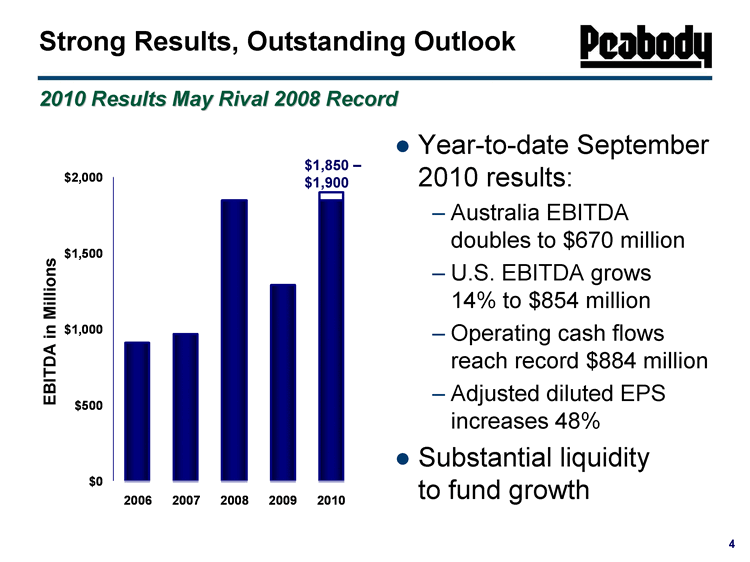
| 4 2006 2007 2008 2009 2010 EBITDA 909.7 969.7 1846.9 1290.1 1850 50 Year-to-date September 2010 results: Australia EBITDA doubles to $670 million U.S. EBITDA grows 14% to $854 million Operating cash flows reach record $884 million Adjusted diluted EPS increases 48% Substantial liquidity to fund growth $1,850 - $1,900 Strong Results, Outstanding Outlook 2010 Results May Rival 2008 Record EBITDA in Millions |

| 5 Peabody's Margins Outperform U.S. Peers Source: Gross margin data obtained from publicly filed documents for the period ending Sept. 30, 2010. Australian exports levered to rising international demand and pricing Cost management and productivity enhancements drive continued margin expansion YTD Gross Margins Peabody vs. U.S. Peers |

| Early Stages of Coal's Supercycle |

| 7 Major New Global Build Out of Coal Generation Under Way Source: Platts Worldwide Power Plant Database; EIA International Energy Outlook 2010 and Peabody analysis. Growth of global coal-based generation (billion kilowatt hours) based on 2007 - 2035 EIA data. Generation Demand Driven by Asia and Growing Share of Electricity Projected New Coal-Fueled Generating Capacity (GW) Global generation expected to grow by 400 GW by 2015 270 MTPA coal growth just in new plants starting up in 2010 Additional 1+ billion tonnes of new demand anticipated by 2015 2010 2011-2015 2015-2035 China 55 250 India 13 75 ROW 19 66 821 7 |

| 8 8 Global Met Coal Use Forecast to Rise 400 Million Tonnes by 2015 Expected Global Steel Production And Met Coal Demand Source: World Steel Association; third party data and Peabody analysis. Global steel production expected to rise nearly two-thirds by 2020 Bulk of market share growth in China and India Trend highlights structural shortage of premium coking coal Other India China EU/US 2010 2015 2020 ROW 696.1 831.6 969.3 China 645.9 955.9 1207 India 64 90.5 125.7 Met Coal Demand 937 1262 1534 Met Coal Demand (Million Tonnes) Steel Production (Million Tonnes) |

| 9 9 U.S. growth presented in short tons. Source: World Energy Outlook 2009, International Energy Agency; Annual Energy Outlook Forecasts, Energy Information Administration; Peabody analysis. China and India Lead Long-Term Coal Demand Growth +690 +2,210 +150 +50 +110 +380 Developing Asia Represents 90% of Long-Term Global Coal Demand Growth 2007 - 2030 (Tonnes in Millions) |
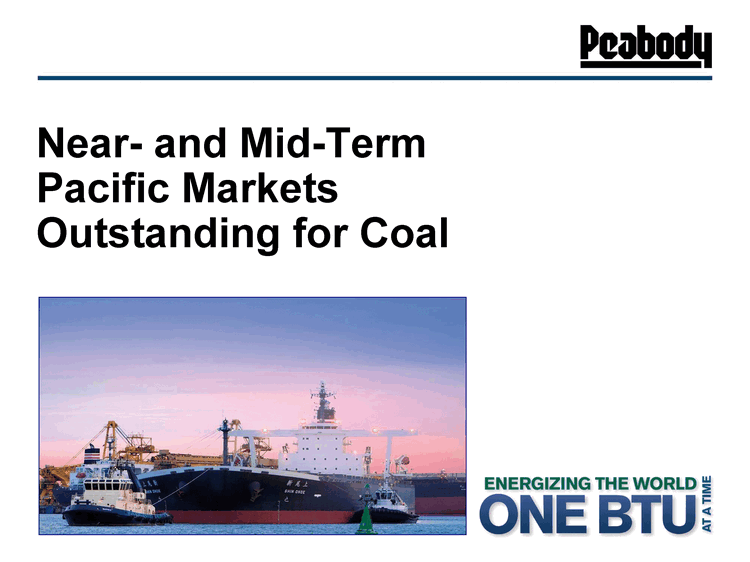
| Near- and Mid-Term Pacific Markets Outstanding for Coal |

| 11 11 Seaborne Thermal Coal Market Short Next Five Years; Implies Strong Pricing Driver 2010 2011 2012 2013 2014 2015 Atlantic 0 6 19 29 35 37 Other Pacific 0 5 17 30 50 60 China 0 2 4 6 8 13 India 0 20 40 60 80 90 Expected Increase in Seaborne Thermal Demand 2010 - 2015 India 125%-175% China 5%-25% Other Pacific ~20% Atlantic ~25% Expected Increase in Seaborne Thermal Supply 2010 - 2015 2010 2011 2012 2013 2014 2015 Australia 0 10 32 47 55 60 Indonesia 0 9 21 35 39 40 Russia 0 2 2 4 6 10 South Africa 0 2 5 7 9 9 Colombia 0 1 2 4 8 16 Other 0 0 1 2 10 15 Shortfall 0 9 17 26 46 60 Australia 30%-60% Indonesia 15%-25% Russia S. Africa Colombia Other Source: Peabody analysis. 2010 2015 2010 2015 50-75 Million Tonne Shortfall |

| 12 12 2015 Australia 37 Mongolia 14 Other Pacific 15 Russia 5 Seaborne Met Coal Market Fundamentally Short 2015 Brazil 20 India 14 China 15 Europe 4 South Korea 6 Japan 4 Other 2 Expected Increase in Seaborne Met Demand 2010 - 2015 Expected Increase in Seaborne Met Supply 2010 - 2015 30-40 ~10 ~10 0-5 (20-25) 55-65 Tonnes in millions. Source: Peabody analysis. 30-40 South Korea Other Atlantic |

| 13 China Dependent on Imports to Balance Supply / Demand Shortfall Driving Net Imports Reliance Dramatic, sustained demand growth Consolidation, rising domestic costs Lack of premier coking coal Supply growth distant from load Growing coastal steel mills and power plants ~600 MTPA of coastal coal movements already occurring |

| 14 2003 2004 2005 2006 2007 2008 2009 2010 Est. 2011 Est. Imports -83.124 -67.963 -45.548 -24.988 -2.087 -4.449 69.6 107.7 115 34.6 29.8 0 Data based on industry reports; 2010 reflects Jan. - Sept. annualized and Oct. - Dec. Peabody estimate. China Net Coal Imports 135 - 140 The Result: Ongoing Reliance on Coal Imports by China ? Jan. - Sept. Jan. - Sept. Oct. - Dec. Oct. - Dec. |

| 15 2009 2010 2011 2012 2013 2014 2015 Met 28 36 38 43 45 47 52 Met Thermal Range 5 8 12 18 20 25 Thermal 50 68 88 100 120 140 150 Forecast Thermal Range 15 20 25 30 45 50 India Likely to be World's Fastest Growing Coal Importer Data and estimates based on industry reports and Peabody analysis. Units under construction have projected start dates of 2011 - 2015. Projected India Coal Imports Imports Projected to Exceed 200 Million Tonnes in Several Years Imports projected to grow ~200 MTPA in 5 years Generation growing 6% - 8% per year 75 GW of new coal- based generation under construction Met Thermal Forecast |

| 16 2009 2010 2014-15 Seaborne Thermal 9.6 11.5 15 0.5 2 Expanding Australia Platform: Targeting Sales Up to 40 MTPA by 2014 Tons in Millions 2009 2010 2014-15 Seaborne Met 7 9.5 12 1 3 11.5 - 12.5 15.0 - 17.0 9.6 9.5 - 10.0 12.0 - 15.0 6.9 Met Coal Sales Estimates Seaborne Thermal Coal Sales Estimates Up to 42% Up to 45% Unpriced Met Volumes: >95% in 2011; 100% in 2012 Unpriced Seaborne Thermal Volumes: ~65% in 2011; ~85% in 2012 2009 values are 'as reported' actuals. |
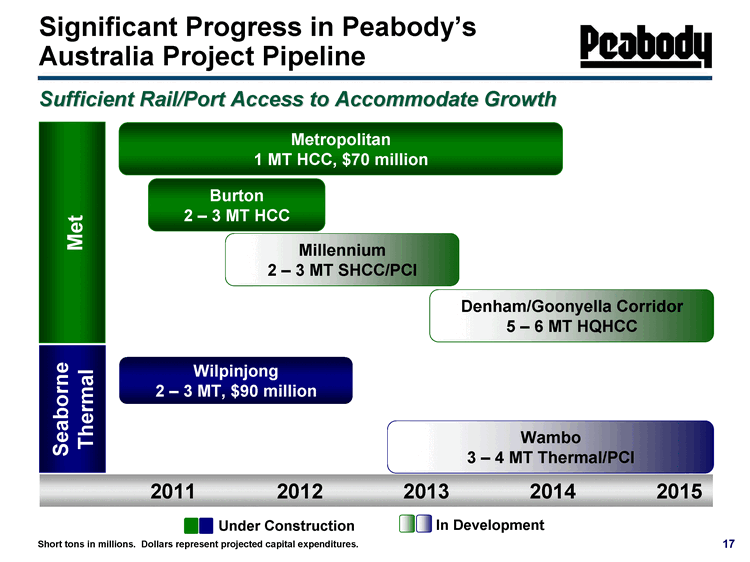
| Significant Progress in Peabody's Australia Project Pipeline Met Seaborne Thermal Metropolitan 1 MT HCC, $70 million Burton 2 - 3 MT HCC Millennium 2 - 3 MT SHCC/PCI Denham/Goonyella Corridor 5 - 6 MT HQHCC Wilpinjong 2 - 3 MT, $90 million Wambo 3 - 4 MT Thermal/PCI 17 Short tons in millions. Dollars represent projected capital expenditures. 2011 2012 2013 2014 2015 Under Construction In Development Sufficient Rail/Port Access to Accommodate Growth |
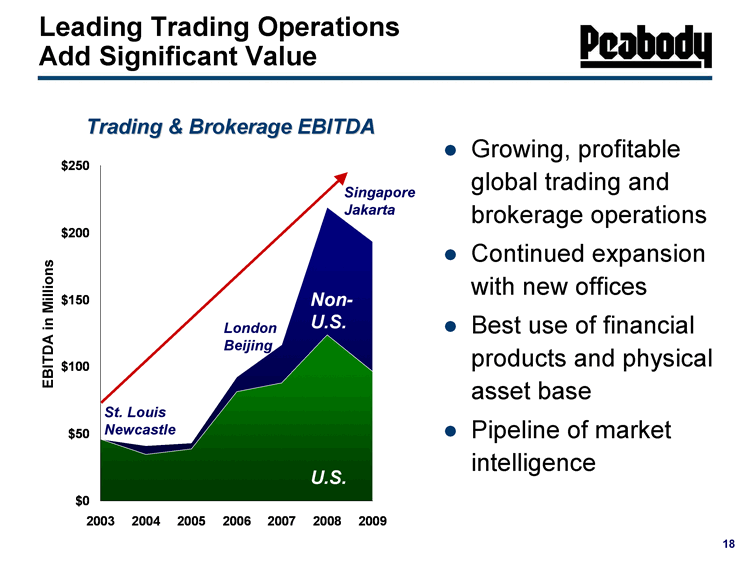
| 18 Leading Trading Operations Add Significant Value Growing, profitable global trading and brokerage operations Continued expansion with new offices Best use of financial products and physical asset base Pipeline of market intelligence 2003 2004 2005 2006 2007 2008 2009 Domestic EBITDA 45.828 34.781 38.745 81.604 87.781 123.683 96.7 International EBITDA 0 6.258 4.313 11 28.819 95.217 96.7 EBITDA in Millions St. Louis Newcastle London Beijing Singapore Jakarta Trading & Brokerage EBITDA Non- U.S. U.S. |

| 19 20 MTPA Open-Cut JV Project 15 MTPA Open-Cut JV Project 12 MTPA Open-Cut JV Fueling Coal-to- Chemicals Project 15 MTPA Open- Cut JV Fueling Clean Coal Project Beijing Tianjin Shanghai Xinjiang Inner Mongolia Guangdong Hong Kong Fujian Zhejiang 15 MTPA Open-Cut JV Project Long-term Initiative Mid-term Initiative Legend Taiwan Near-term Initiative Closed deal Peabody Advancing Robust China Project Pipeline 20 MTPA Open-Cut JV Project 30 MTPA Open-Cut JV Project 6% Equity Partner GreenGen Clean Coal Project 15 MTPA Open-Cut JV Project |
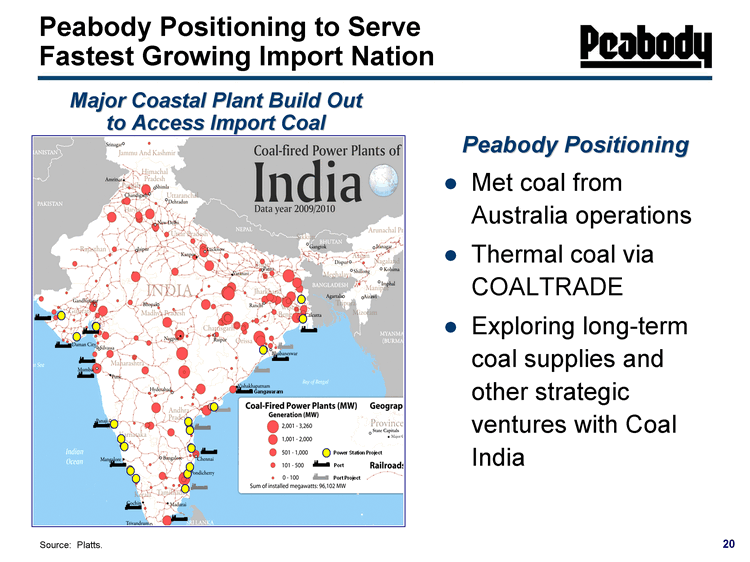
| 20 Peabody Positioning to Serve Fastest Growing Import Nation Peabody Positioning Met coal from Australia operations Thermal coal via COALTRADE Exploring long-term coal supplies and other strategic ventures with Coal India Source: Platts. Major Coastal Plant Build Out to Access Import Coal |
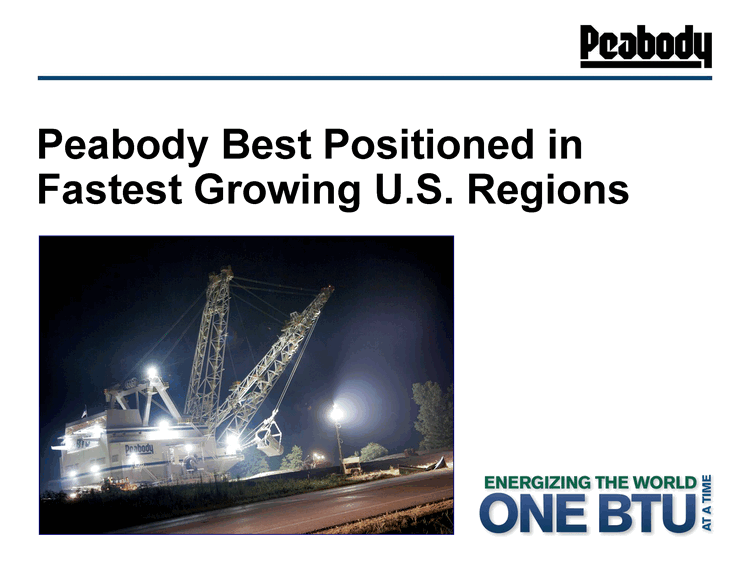
| Peabody Best Positioned in Fastest Growing U.S. Regions |

| 22 U.S. Coal Demand On Pace for 60 - 80 Million Ton Recovery in 2010 Source: Energy Information Administration; MSHA; National Mining Association and other third-party sources. 2009 vs. 2010 Expected Demand 2009 2010 East 1062 1062 Electric Generation 31 Gas Back to Coal 10 U.S. Exports 20 Other 10 Electric Generation Gas Back to Coal U.S. Exports Other Electricity Generation Gas Back to Coal U.S. Exports Other 60 - 80 Million Tons Tons in Millions 2010 Highlights Demand up on weather- driven power generation Coal production down more than 10 million tons 2011 Drivers New coal generation Additional economic activity Improving industrial load Further coal-to-gas reversal Result: Stockpile levels expected to fall |
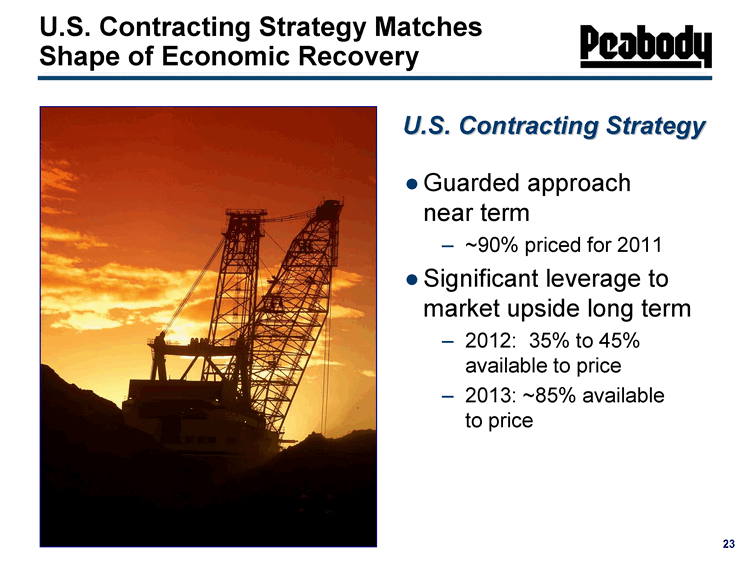
| 23 U.S. Contracting Strategy Matches Shape of Economic Recovery U.S. Contracting Strategy Guarded approach near term ~90% priced for 2011 Significant leverage to market upside long term 2012: 35% to 45% available to price 2013: ~85% available to price |

| 24 SPRB and Illinois Basin: Majority of U.S. Coal Demand Growth PRB Advantage Low end of cost curve Primary source for new plants Asian export potential Illinois Basin Advantage Lower cost than Appalachia Major source for new plants CAPP to Experience Significant Decline Constraints driven by safety, permitting and geology challenges SPRB ILB NAPP Other CAPP 2009 76 45 -3 -6 -40 U.S. Production Change 2010 - 2015 (Tons in Millions) 70-80 40-50 (0-10) (0-10) (40-50) Estimates based on Peabody analysis and industry reports. 2009 Production: 417 103 127 232 196 |

| Peabody's Catalysts for Growth & Shareholder Value Upside |

| 26 26 Peabody Energy: Catalysts for Growth Bear Run Mine Expanding Production Multiple PRB Export Opportunities in Development Expanding Australia Seaborne Met, Thermal Volumes Metropolitan, Wilpinjong and Burton Construction Commenced Multiple JVs and Large Project Pipeline in China Pursuing Mongolia Opportunities, including JV with Winsway Strategic Discussions with Coal India for Long-term Supply Pursuing Indonesian Projects, Partners Expanding Global Trading & Brokerage School Creek: Best Long-term PRB Capacity Gateway Mine Expansion |

| 27 Peabody Energy: The Only Global Pure-Play Coal Investment Coal long-term supercycle is in the early stages BTU: Unique assets, market position and prospects Best access to fastest growing global markets #1 in lowest cost and fastest growing U.S. regions Significant catalysts for growth and increased shareholder value |

| 28 28 Dahlman Rose Global Metals, Mining & Materials Conference November 17, 2010 Christina Morrow Vice President Investor Relations |